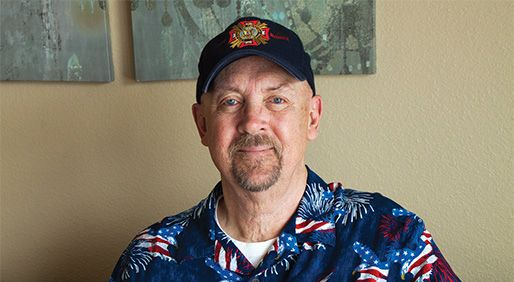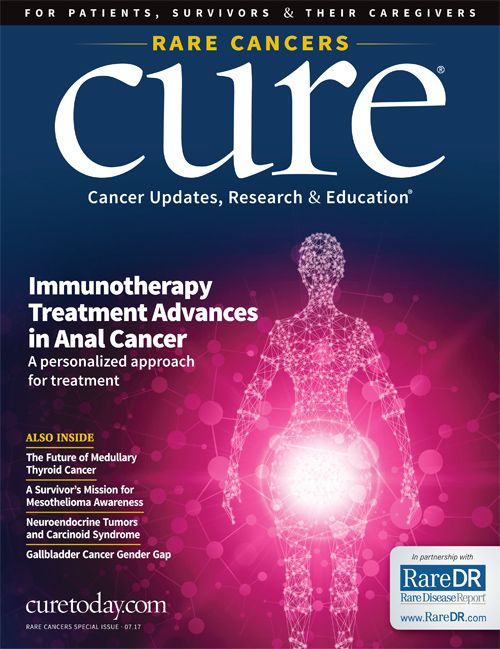Publication
Article
CURE
Hitting a Target in Gastrointestinal Stromal Tumors
Author(s):
How zeroing in on the mutation in gastrointestinal stromal tumors is adding years to patients’ lives
ROBERT LITTLE joined a clinical trial through MD Anderson and was one of a few patients who responded to treatment. More than six years later, he still has no evidence of disease. - PHOTO BY: LEEANNE RAMBIN

ROBERT LITTLE joined a clinical trial through MD Anderson and was one of a few patients who responded to treatment. More than six years later, he still has no evidence of disease. - PHOTO BY: LEEANNE RAMBIN
In May 2007, Robert Little checked into a small community hospital near his home in central Pennsylvania. He’d been mysteriously under the weather for a few weeks. When blood tests revealed that he was losing ground to a deep infection of unknown origin, he was quickly transferred to a larger hospital. Barely out of the ambulance, he was prepped for emergency exploratory surgery.
The surgeon removed a perforated tumor and a section of his small intestine, but the local pathologist was stumped and shipped the tumor to Mayo Clinic in Minnesota for further analysis. By the time the diagnosis — gastrointestinal stromal tumor (GIST) — filtered back to Little, he was on the mend. “My surgeon said, ‘That’s not really cancer, it’s something in between,’ says Little, who had never heard of GIST. “So, I just forgot about it.”
His heart saved him in 2011 when an ultrasound exam for an aneurysm also spotted something scary on the liver. After a short panic about liver cancer, Little’s doctor reminded him of the GIST, and before long they confirmed the disease had returned, but this time it was metastatic.
GIST is a rare cancer afflicting only about 5,000 people each year in the United States. That rarity accounts for some of the confusion and casual attitude surrounding Little’s first diagnosis. Most cancers are carcinomas, affecting specific organs, such as the brain, breast and lungs. Sarcomas target more diffuse organs — connective tissue such as the bones, muscles and blood vessels. GIST arises from highly specialized cells that control the slow contractions of the gastrointestinal (GI) tract, so it can intrude anywhere from esophagus to rectum. And although it is one of the most common of more than 50 types of sarcoma, for years doctors didn’t recognize it as a distinct cancer. The name was first proposed in 1983, but it didn’t mean much until 1998 when researchers revealed an incriminating mutation in the KIT gene that encodes the CD117 protein, which is involved in cell growth signaling. Until that KIT fingerprint was found, GIST was often misclassified as a smooth muscle sarcoma.
With a clear diagnosis of metastatic cancer, this time Little did his homework and sought a consultation at The University of Texas MD Anderson Cancer Center in Houston. Soon he realized he’d walked into a world where GIST was not an afterthought but a major character in the next exciting chapter in cancer treatment.
Targeting the Disease
Chemotherapy is a blunt instrument. Cancer cells are always dividing, and so the goal of chemotherapy is to preferentially destroy dividing cells. Unfortunately, this approach can be too broad and can kill immune, hair and other healthy cells. The next generation of drugs, called targeted therapy, tries to avoid this collateral damage by targeting specific cancer mutations that “drive” abnormal cell growth.
Almost as soon as the KIT connection was made in GIST, oncologists realized they already had an exciting new drug to target the mutation. The KIT mutation leads to the creation of an overly active enzyme, specifically a tyrosine kinase that activates cell growth pathways. Gleevec (imatinib), a tyrosine kinase inhibitor (TKI), was among the first targeted therapies, quickly delivering extraordinary results in chronic myeloid leukemia (CML), associated with a different mutation that is also susceptible to Gleevec.
And, Gleevec worked wonders in its very first GIST patient. “We observed spectacular responses that really had never been seen before in solid tumors,” says Jonathan Trent, M.D., Ph.D., director, Sarcoma Program, Associate Director, Clinical Research at the Sylvester Comprehensive Cancer Center at the University of Miami. “We saw a profound number of GIST cells dying only three days after starting this medicine.”
Over time this dramatic biological action translated to years of survival for patients. Prior to Gleevec, a patient with metastatic GIST survived an average of only 7 months. Now it’s more than five years. Since first approved for metastatic GIST in 2002, its use against the disease was expanded in 2008 to use for one year after potentially curative surgery for early stage disease to lower risk of recurrence, and again in 2012 extending the period to three years. Some patients enrolled in the original Gleevec study are still taking the drug, 12 years later.
Gleevec leverages the kinase reactions at the heart of the protein encoded by the KIT gene, and soon other drugs using a similar strategy emerged. Sutent (sunitinib) was approved in January of 2006, while Stivarga (regorafenib) won approval in February 2013.
Unfortunately, these drugs don’t work indefinitely. About half of GIST patients who initially respond to Gleevec develop resistance to the drug in the first two years. Sutent and Stivarga are the Food and Drug Administration-approved next lines of defense, and can stand in — sometimes for years. But the everevolving nature of cancer means that resistance eventually develops in 90 percent of cases.
“Gleevec is the best drug we ha ve for this disease,” says Syma Iqbal, M.D., associate professor of medicine, at the USC Norris Comprehensive Cancer Center in Los Angeles. “Unfortunately, these tumors still develop resistance to our best drug, so we still lose the battle earlier than we want to.”
“Even if they’ve had three or four prior treatments, often those patients are feeling well enough to receive therapy,” adds Margaret von Mehren, M.D., chief of sarcoma research at Fox Chase Cancer Center in Philadelphia. Tackling this resistance challenge requires both a better understanding of how it happens, and the development of more and better drugs.
Little arrived at MD Anderson as researchers were searching for answers to this resistance problem. Tasigna (nilotinib) is yet another TKI that, like Gleevec, first showed promise in CML. After reviewing his options, he joined a clinical trial comparing Tasigna with Gleevec (Trent was the principal investigator). Little was assigned to receive Tasigna. The trial was ultimately ended because Gleevec outperformed Tasigna, but in a lucky twist, Little was one of the few patients who responded. He’s now been on the drug for more than six years, still with no evidence of disease.
The extraordinary effectiveness of Gleevec is a doubleedged sword, making it harder to study potential advances.
For example, Sutent and Stivarga may be every bit as good as Gleevec. It’s also possible that Sutent and/or Stivarga would work better than Gleevec as the first drug tried. But with so few GIST cases, it’s hard to get enough patients into any given trial. And Gleevec is already so powerful that it’s hard to justify not giving it to a patient. To compare the three, about 1,000 patients would be needed in each arm of the trial. “It’s very hard to do those trials in a rare disease,” says Trent. “When we discuss treatment options the level of data that we have to support those recommendations is not the same as we would have, for example, in breast cancer,” adds von Mehren. The numbers just aren’t powerful enough to predict measures such as overall survival. “We have less data to help support a decision,” she says. “I often feel like maybe I’m sounding wishy-washy, but that’s the state of the data.”
Trial and Error
In the beginning, nobody was particularly worried that Lindsay Hughes was feeling terrible. “I would just get sick for a day or two. Down for the count and feeling really terrible,” she says. “I’d bounce right back and go back to doing my normal 17-year-old stuff.”
Worried about missing too much school, she asked her doctor to take a closer look. With a family history of gallbladder problems, her doctor scheduled an ultrasound. When the but she’ll stay on it until the tumor progresses. She knows about resistance — almost expects it. But since her doctors didn’t expect that she would survive to attend her high school graduation, she greets each day with the belief that today could be the day she hears of a cure. “It teaches you to be a little more thankful and not so entitled,” Hughes, now 26 years old, says. “I was 19 when I started my first clinical trial and I was like: ‘Why are they so nosy? Why do they keep asking me the same questions every time?’”
Now she understands. “I’m writing the future for somebody else’s life,” she says. And she has embraced the questions. “Ask as many questions as you can,” she advises. “If your doctor makes you feel uncomfortable for asking questions, then maybe you need a new doctor.”
Trent, who is involved in many immunotherapy trials, is excited by other new treatment technologies. Earlier this year, he worked with a newly diagnosed GIST patient who was 24 weeks pregnant.
The goal was to find the least toxic therapy to both enhance the mother’s chances of survival and protect the baby. Unfortunately, her hospital didn’t keep enough tissue to allow for tumor typing and he didn’t want to risk another biopsy. “We didn’t know what to treat her with,” he says.
Trent turned to a circulating tumor DNA test nicknamed a “liquid biopsy,” which culls stray bits of tumor DNA from the blood. It’s particularly exciting for oncologists because, in metastatic disease, a single biopsy doesn’t necessarily provide complete intel. Cancer, especially metastatic disease, can begin to develop in different directions, and might need a combination of drugs to control it. Trent used the circulating tumor DNA along with advances in tumor typing to confidently prescribe Gleevec. The patient was able to carry her baby to 30 weeks — not quite full term, but the delivery was spontaneous, and the baby healthy.
The ‘Flavor of Cancer’
A drug like Gleevec embodies both the promise and the frustration of targeted therapy. It works as expected and it works well. Yet it doesn’t cure metastatic GIST, and doesn’t work for all patients with GIST. And while resistance is a problem, almost 20 years later, it’s still the best drug available.
It’s not for lack of trying. The number of drugs currently in testing for GIST is daunting. Hughes knows: she’s on her sixth drug in seven years, including two clinical trials. She doesn’t remember the name of one drug, she was on it so briefly. Among the current clinical trials for GIST are: Masivet (masitinib), Luminespib (NVP-AUY922), Binimetinib (MEK162, ARRY-162), Sprycel (Dasatinib), Ibrance (palbociclib), selumetinib, BBI503 and PLX9486. Immunotherapy is also being tested via vaccine (intuvax) and with Opdivo (nivolumab), Keytruda (pembrolizumab) and Yervoy (ipilimumab).
For all of these, results are only preliminary. “There’s a lot of promise, but we don’t know what’s going to be a success,” says Trent.
For early stage GIST, three years of Gleevec is currently recommended to minimize the chance of recurrence and maximize the chance of longterm cure. However, there is some debate as to whether these patients should take life-long therapy.
The real potential seems to be in the increasing sophistication of the oncology community’s ability to read tumor mutations. “As we do expanded sequencing in those tumors that don’t seem to have regular mutations, we are finding some rare things that potentially are targetable,” using existing drugs developed for those mutations in other cancers, explains von Mehren. Still, other drugs like BLU-285, DCC-2618 and crenolanib target rarer KIT and Platelet-Derived Growth Factor Receptor (PDGFR) mutations in GIST.
Providing access to these drugs and, in turn, enrolling enough patients to test them, requires global collaboration of many individuals and institutions.
Clinical trials need significant infrastructure and are more costeffective when a single center works with a number of patients, but that’s simply not possible with GIST. “For a rare tumor, we might only have one or two patients on a study,” she says.
While this may seem like a difficult challenge, Iqbal argues it’s actually the future of cancer care. “In oncology, we’ve been groupers for years,” she says. Tumors of any particular disease, such as lung, breast or colon cancers, were lumped together, and given a therapy that might work for 30 to 40 percent of patients. Now these diseases are being split into tumor types based on their individual molecular characteristics, and having the right mutation opens the doors to far more effective therapy. “I think in all diseases were going to become, more and more, splitters,” Iqbal says. “We’re going to start making all of these diseases rare diseases because we are going to be so specific in how we approach treatment based on what your tumor profile looks like.”
Or, as Little now understands it: “Cancer is not cancer — there are so many different flavors of it.”
imaging picked up a large abdominal mass, her “quick” hospital visit stretched to days and ultimately a transfer to Portland — more than 180 miles from her home in Yakima, Washington. A 16-hour surgery took not only her gallbladder, but 95 percent of her stomach. The GIST was the size of a 2-liter bottle. The initial assessment was not metastatic, but 18 months later, scans revealed spots on the liver.
Because of its track record, Gleevec was tried first. It didn’t work, and that wasn’t a surprise. Hughes has a rare GIST subtype known as pediatric wild-type (without the KIT mutation) and there is no approved treatment. Sutent came next, and, ironically, may have worked too well — killing her cancer so quickly that she nearly bled to death, twice.
Now, she’s on her second clinical trial drug, Iclusig (ponatinib), which tackles the KIT mechanism differently. The trial was canceled because she was the only patient responding,





